|
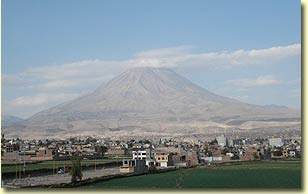 The majority of Peruvians either reside high up in the Andes Mountains,
along the Pacific coastline or in small communities in the mighty Amazon
Jungle. Arequipa will take your breath away. Not because it is nestled
some two and a half thousand metres up in the Inca mountains, its sheer
magnificence and beauty is awesome. The majority of Peruvians either reside high up in the Andes Mountains,
along the Pacific coastline or in small communities in the mighty Amazon
Jungle. Arequipa will take your breath away. Not because it is nestled
some two and a half thousand metres up in the Inca mountains, its sheer
magnificence and beauty is awesome.
The sun shines down on the dusty baron landscape surrounding the
city for ten months of the year. The air is bone dry, the skies are for
the most part cloudless and temperatures constantly hover around a
pleasurable twenty five degrees.
Being at a higher altitude and closer to the sun makes it feel warmer
than it really is. A quick glance towards the snow capped peaks of
El Misti, Chachani and
Pichu Pichu, three mountains that surround the
northern section of the city, does have a cooling affect. El Misti in particular is so extraordinary; it protrudes from the
barren
floor of the plateau on the north east side of the city to reach a
height just shy of six thousand metres. The fast paced icy waters that
run down the Chili River Valley from the mountains provide irrigation
for the farmland and allotments in one of the driest areas in the world. really is. A quick glance towards the snow capped peaks of
El Misti, Chachani and
Pichu Pichu, three mountains that surround the
northern section of the city, does have a cooling affect. El Misti in particular is so extraordinary; it protrudes from the
barren
floor of the plateau on the north east side of the city to reach a
height just shy of six thousand metres. The fast paced icy waters that
run down the Chili River Valley from the mountains provide irrigation
for the farmland and allotments in one of the driest areas in the world.
Arequipa has no ultra modern skyscrapers, office towers or fast paced
freeways that would otherwise spoil the heart of this conurbation.
People that have spent their lifetime in the white city, so named for
the white volcanic blocks used in the city's construction, will tell you
they are not from Peru, they are Arequipan, and the city is a legendary
entity on its own.
On the outskirts of the city one can see terraces, built by the Incas,
centuries before the Spanish arrived, that are still farmed today.
Looking at this stepped landscape across flower covered white stone
buildings enhanced by the backdrop of crystal clear cobalt sky; one
understands why local folks believe Arequipa is a paradise.
 After
many hours of somewhat boring and wearisome travel, my flight was about
to touch down in the heart of the Andes. I was to see first hand what
life in this beckoning part of the world is all about.
My mission was to work with staff and students of the “Instituto de
Sur”, a hospitality College in the downtown core of the city. ISUR, was to be one of many industry participants in the debut of a
festival promoting the foods and beverages of the area. The event was
called “Festigloton”, and yes, it translates exactly as it sounds. After
many hours of somewhat boring and wearisome travel, my flight was about
to touch down in the heart of the Andes. I was to see first hand what
life in this beckoning part of the world is all about.
My mission was to work with staff and students of the “Instituto de
Sur”, a hospitality College in the downtown core of the city. ISUR, was to be one of many industry participants in the debut of a
festival promoting the foods and beverages of the area. The event was
called “Festigloton”, and yes, it translates exactly as it sounds.
My trip was put together thanks to
Niagara College's International Education and Development Division's
"Entry Points for Tourism Work" project. The project is financed
in large part by CIDA and administered by the Association of Canadian
Community Colleges.
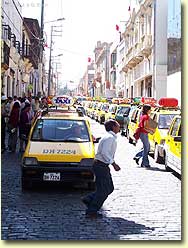 The drive from the airport to downtown was, well let’s say a reality
check.
Peru is a poverty stricken country of some twenty seven million people,
fifty four percent of which live in dire conditions. Neighborhoods on
the outer perimeter of the city house people in homes constructed of
corrugated iron and cardboard without running water or hydro. The drive from the airport to downtown was, well let’s say a reality
check.
Peru is a poverty stricken country of some twenty seven million people,
fifty four percent of which live in dire conditions. Neighborhoods on
the outer perimeter of the city house people in homes constructed of
corrugated iron and cardboard without running water or hydro.
Few people can afford the privilege of driving. Consequently taxis are
plentiful, unbelievably cheap and do seem to take total possession of the
roads. Picture a NASCAR race, only with thousands of participants all
competing with one another through tiny narrow streets and intersections
and you have an understanding of the routes throughout the core of city.
(borrowed picture of cabs)
After only a few of the many cabs I would take, I concluded stop signs
are an inconvenience, shock absorbers a rarity, police cars and
speed traps are non existent, seat belts may or may not function and cab
doors often do not fully close. On one such trip the driver had to run
around to open my door as there was only a hole in the door where a
handle had once been.
During one early morning trip to ISUR, my cab slowed down to a crawl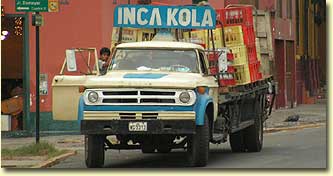 eventually sputtering to a complete stop. My driver, with a sheepish
grin, jumped out and grabbed an “Inca Kola”
bottle filled with gas from the trunk.
After turning over the engine a dozen times, there was a deafening bang,
followed by a cloud of black smoke. The cab was restored to life and off
we went.
eventually sputtering to a complete stop. My driver, with a sheepish
grin, jumped out and grabbed an “Inca Kola”
bottle filled with gas from the trunk.
After turning over the engine a dozen times, there was a deafening bang,
followed by a cloud of black smoke. The cab was restored to life and off
we went.
Having painted such a picture of peril, death and destruction on the
roads, I have to say I never witnessed as much as a fender bender let
alone a serious accident.
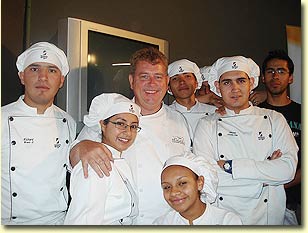 My purpose at the festival was to perform three demonstrations on fusion
food using Arequipan recipes as the foundation. I must confess to being
a little anxious, but after meeting the staff and student volunteers at
the college, the warm and genuine welcome I received calmed my nerves
completely. My purpose at the festival was to perform three demonstrations on fusion
food using Arequipan recipes as the foundation. I must confess to being
a little anxious, but after meeting the staff and student volunteers at
the college, the warm and genuine welcome I received calmed my nerves
completely.
For my first demonstration, I made Italian Gnocchi dumplings. Instead of
the traditional tomato and basil, the sauce was laced with several
Peruvian chilies, Rocoto and
Aji finished with pulverized lettuce and a
Huacatay, a Peruvian herb also known as black mint.
Going out for Ceviche is as common in this part of the continent as
eating fast food is in the North. I employed the technique of preparing
Ceviche for my second dish, serving the lightly cured mixture of ultra
fresh fish on a Vietnamese glass noodle salad with mango and papaya
laced with an Asian vinaigrette.
When I left Canada, I knew little about the foods of Peru other than a
little last minute online research. Peruvian food is renowned as being
the best in South America. What I ate here can attest to that statement.
Seven thirty pm was the scheduled time for my first presentation so we
had plenty of time to relax and enjoy a leisurely lunch.
This was my first encounter with
Pisco Sour, a much loved aperitif
composed of seven parts local brandy distilled from Quebranta or Muscat
grapes, with three parts lime juice, one part simple syrup, an egg white
and a splash of Angostura bitters. Delicious!
My only request to my hosts was to eat authentic non tourist foods
indigenous to the area. That was never to be an issue. Lunch started
with a plate of fava beans with Aji pepper and peanut dipping sauce and
some delectable cubes of fried Queso Blanco.
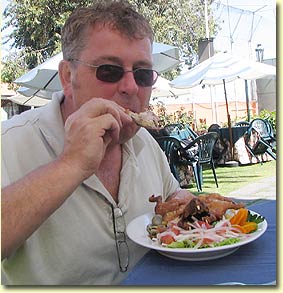 My main course was authentic, I chose to tackle a whole deep fried
Guinea pig complete with liver, kidneys and other such dangly bits.
It tasted similar to pork, only richer and more complex. I really
enjoyed it. My main course was authentic, I chose to tackle a whole deep fried
Guinea pig complete with liver, kidneys and other such dangly bits.
It tasted similar to pork, only richer and more complex. I really
enjoyed it.
Many restaurants have tables set in large grass covered courtyards where
around two in the afternoon, patrons are entertained by a small Latino
band and/or Peruvian dancers. I could have sat around all afternoon,
sipping on Pisco Sours enjoying the merriment, but we had to get back to
the college and get set up.
My student assistants proved to be invaluable and soon tray after tray
of food was set ready to transfer to the Plaza de Yanahuara, the venue
for the festival.
The college does not have the use of a van for transportation so we piled
into several taxis with our methodically set trays of “mise en place” on
our laps.
Perhaps it was a combination of pre performance nerves, the taxi
navigating the bumpy cobbled streets or the effects of one too many
Pisco Sours, but I knew the little rodent I made acquaintance with some
four hours prior was eager to leave by the fastest exit he could find.
Not wanting to embarrass myself in front of the students in my cab, I
spent the entire, seemingly endless, journey with my arse squeezed so
tight I pulled muscles in my thighs that hurt for several days after.
Thanks to the skills of my wonderful interpreter,
Vanessa Corlazzoli, the
demonstration went off without a glitch. We had a small open booth about
the size of a kitchen in an average home. There were some fifteen seats
set up inside and plenty of standing room in front of the stoves.
Despite the twenty foot long papier-mâché bull leading a procession of
marching characters on stilts banging drums almost bulldozing its way
through the pavilion, all went well.
Trips like this make me realize just how fortunate we are living the
life style that we do. The average Peruvian does not have the Internet
privileges that we have access to, libraries do not exist and good
quality books are not cheap and are hard to find. The fact that my
audience was taking note of every word that left Vanessa’s mouth
inspired me to do the best possible job I could.
It could not have been easy to translate for a chef; we tend to use
culinary terms not used in everyday conversions and play around with
ingredients not found on regular supermarket shelves. However, Vanessa
was well prepared and performed the task commendably. Born in Uruguay,
Vanessa moved with her family to Canada before she saw her teenage
years. Fluent in both Spanish and English, Vanessa has been living in
Arequipa for the past month working for the ISUR on a project designed
to assist less fortunate people living in makeshift homes on the
outskirts of the city.

On the Saturday, day two, I was slotted to present a demonstration on
centre stage to several hundred people.
Chupe de Camarones is a specialty of Arequipa, a remarkable
crayfish
chowder brimming with chunks of Inca corn, potatoes, a poached egg, Rocoto peppers and rice. The key to the success of this soup is browning
the crayfish shells complete with their coral, rendering a rich rusty
brown stock that becomes the foundation of the chowder.
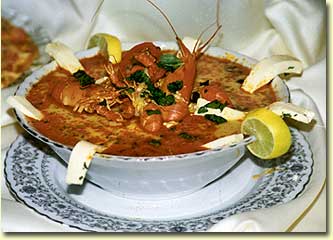
Crayfish are plentiful in this neck of the woods and it was fun to be
able to cook with them. I had packed a number of my favourite Asian
pastes and spices before I left Canada to use for the event. My fusion
version of the Chupe borrowed techniques and flavours from the Bourride
in France and South East Asia made its mark by donating red curry paste,
lime leaves and lemon grass. Coconut milk replaced the evaporated milk
used in the conventional recipe.
It was blisteringly hot, the wind
wreaked havoc with my propane
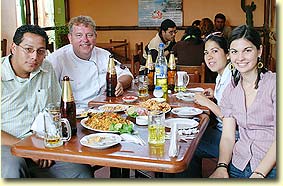 burners
and the intense brightness of the sun made video reproduction difficult.
All in all it went really well, people were appreciative and the
bottle of icy chilled Arequipina beer slurped down immediately after was
most welcome. burners
and the intense brightness of the sun made video reproduction difficult.
All in all it went really well, people were appreciative and the
bottle of icy chilled Arequipina beer slurped down immediately after was
most welcome.
It was time for lunch. Vanessa,
Marianna, a talented young pastry
instructor and a few of our student helpers wandered out into the
streets in search of some Ceviche. Good Ceviche is not that
hard to find in this country. Having made Ceviche on many occasions, I
now know I have been doing it wrong all these years.
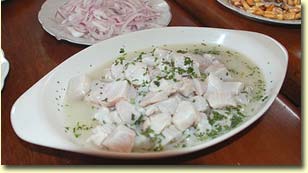
It is simple.
One: Start with ultra fresh fish (a no brainer)
Two: Marinate for a matter of minutes, enough to barely change the colour of the surface of the fish. It should just start to turn white,
but remain translucent so as to see the original hue of the fish.
Three: Use the right limes. Peruvian limes have seeds and the juice is
less acidic than the ones we are used to. Key limes are the closest
substitute.
Four: Refresh the dish before serving by tossing a
few ice cubes
through the bowl for a couple of seconds then discard any cubes that
remain.
We ate our way through platters of fish and cold steamed mussels in
minutes. I can’t describe the taste well enough to do it justice. It was
just so perfectly balanced, the degree of citric acid was so precise and
ultra refreshing. The minced red onion, Aji pepper and cilantro, assumed
the backup role, teasing the taste buds.
I have no idea what fish we ate and I don’t care. It was simply
sensational.
 Juan Carlos, who works at the ISUR mentioned to me that as a chef, I
might enjoy San Camilo, the daily
downtown market. I was there as soon as its doors opened at 5 AM. This place is not for the faint of heart. It is full of vendors
selling anything from animals still warm and bleeding, to vegetables,
fruits and breads. One can find merchants selling dried creatures of all
sorts destined to be part of medicinal potions. Juan Carlos, who works at the ISUR mentioned to me that as a chef, I
might enjoy San Camilo, the daily
downtown market. I was there as soon as its doors opened at 5 AM. This place is not for the faint of heart. It is full of vendors
selling anything from animals still warm and bleeding, to vegetables,
fruits and breads. One can find merchants selling dried creatures of all
sorts destined to be part of medicinal potions.
I witnessed a short and muscular woman carrying a pig hustling through
crowds passing tables strewn with poultry, mountains of fish and sides
of aging lamb and alpaca. A leather skinned sun drenched man dressed in
jeans and a blood soaked t-shirt butchers beef with professional ease as
the potato vendor at another booth flaunts his wares with pride. carrying a pig hustling through
crowds passing tables strewn with poultry, mountains of fish and sides
of aging lamb and alpaca. A leather skinned sun drenched man dressed in
jeans and a blood soaked t-shirt butchers beef with professional ease as
the potato vendor at another booth flaunts his wares with pride.
Peru has some six hundred and twenty three varieties of fruit. The best
deal in the market has to be a pitcher of freshly blended mixed fruit
juice for sixty Soles (65 cents). The kind lady perched behind papayas
of immense magnitude cut slivers of them and whatever other fruits were
within easy reach and juiced them all in a blender right out of a mid
fifties Sears Roebuck catalogue.
Independent vendors take advantage of the market’s proximity by setting
up shop in doorways or simply huddled on the sidewalk selling anything
from a few books of matches to a couple of bundles of herbs. It is a
site to see. Click here to view additional market photos.
This is a magical land and there are so many wonderful reasons to be
here, but being a chef, I really have to talk about pork!
In Peru, pork tastes like pork should, unlike the bland tasting
supermarket renditions raised to be low in fat and therefore low in
flavour that we are subjected to.
 At one lunch I fought my way through a triple pork platter composed of a
Ricoto Relleno,
Chicharron, marinated
Head Cheese and Pig’s Trotters.
The quintessential Peruvian pepper, the Ricoto, is the perfect size to
stuff and offers the diner a layer of heat that is just perfect, spicy,
but full of flavour. The top is removed and the capsule is stuffed with
a mixture I would compare to a Bolognaise sauce only made with pork and
the meat was diced not ground.
Before baking it is topped with Queso Blanco cheese. At one lunch I fought my way through a triple pork platter composed of a
Ricoto Relleno,
Chicharron, marinated
Head Cheese and Pig’s Trotters.
The quintessential Peruvian pepper, the Ricoto, is the perfect size to
stuff and offers the diner a layer of heat that is just perfect, spicy,
but full of flavour. The top is removed and the capsule is stuffed with
a mixture I would compare to a Bolognaise sauce only made with pork and
the meat was diced not ground.
Before baking it is topped with Queso Blanco cheese.
My doctor may not approve of Chicharron. Large hunks of pork, skin and
fat intact are placed into open roasting trays and barely covered in
water before spending hours in the oven. The idea is for the liquid to
evaporate allowing the fat to render and become the principal cooking
medium. As it slowly cooks the skin crisps and all sort of wonderful
flavour and texture changes take place. The end result is similar to a
confit. It tastes so bloody good and could easily become addictive. The
head cheese was tender and tasty, but the little feet could have had more
cooking.
 The ingestion of all that pork fat is probably not the best thing in
what we consider to be part of a healthy well balanced diet, but I know
when the inevitable onslaught of winter arrives, I will be wishing I was
on a sun drench patio in Arequipa eating Chicharron and sipping Pisco
Sours. The ingestion of all that pork fat is probably not the best thing in
what we consider to be part of a healthy well balanced diet, but I know
when the inevitable onslaught of winter arrives, I will be wishing I was
on a sun drench patio in Arequipa eating Chicharron and sipping Pisco
Sours.
My stomach was once again about to explode. A local remedy to combat
this potentially embarrassing situation is an
Algarrobina. A smooth and
creamy concoction that combines egg yolks, sugar, Algarrobita, a syrup
made from the fruit of a Northern Peruvian desert tree, evaporated milk,
cinnamon and a generous shot of Pisco. It tasted like drinking a
liquefied combination of Tiramisu and Egg Nog and it did aid my
digestion.
 The
alpaca is a domesticated species of South American
camelid. Alpacas graze in the heights of the Andes of Southern
Peru at an altitude of 3500 to 5000 meters above sea-level.
While they may look like a sheep in appearance they are larger and have
a much longer neck. They come in a range of colours and are prized for
their wool, which has long helped to support Peru’s excellent reputation
as a fine garment manufacturer. The
alpaca is a domesticated species of South American
camelid. Alpacas graze in the heights of the Andes of Southern
Peru at an altitude of 3500 to 5000 meters above sea-level.
While they may look like a sheep in appearance they are larger and have
a much longer neck. They come in a range of colours and are prized for
their wool, which has long helped to support Peru’s excellent reputation
as a fine garment manufacturer.
As it turns out, alpacas are also quite tasty. Local restaurants and
street vendors offer the loin seasoned with salt and grilled, usually
medium rare and served with an ample amount of French fries. The tender
meat tastes like a cross between pork and lamb with a finish of well
aged venison.
Peru’s wine industry may not yet be in the same league as Chile and
Argentina to the south, but it is starting to get noticed and I did have
the chance to try some.
Tacama Special
Selection 2006: A wealth of aromas include, balsawood, cream, black fruit, black
pepper and black liquorish. After a while it starts to show notes of
mineral, iron, cured meat, green onion, bacon and seaweed. The palate
captures lots of ripe black fruit, almost too ripe, that play along well
with the flavours of the liquorish, toffee, molasses and malt.
There is a layer of silky tannin that coats the teeth. The finish is
quite fruit laden, but a touch of metallic astringency creeps up to
spoil.
For thirty Soles at most street vendor’s stalls and forty five at Lima’s
duty free, it translates to a good value wine that for me is well worth
the money. It might hold up well to a couple of years in the bottle.
Maybe I need to go back to Peru and acquire some more.
One of the more rustic meals I ate was in one of several restaurants
around the city that strive to keep time-honored authentic Arequipian
food alive.
These popular restaurants are called "Picanterías", derived from a
Spanish word meaning hot. A
Picante is a stew simmered in a Ricoto
pepper sauce with vegetables and meat.
A Picante also means a "daily menu" composed of a three courses. The
first course is hearty bowl of robust soup called a "Chupe." Each day of
the week has a corresponding Chupe. On Monday, the day I ate, the Chupe
was ‘Chaque." Each day’s soup has differing ingredients. Friday, for
example, in Catholic tradition, one eats the Chupe de Camarone, the
aforementioned crayfish chowder.
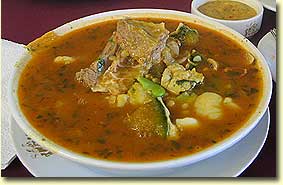 My bowl of Chaque
arrived at the table brimming with chunks of stewed short ribs, tripe
and vegetables in a rich pepper based broth that was good to the last
drop. After I drained my bowl of the delicious and so substantial soup,
I was hard pressed to believe my guest when they told me a main course
would soon arrive. Nonetheless it did, I struggled and dessert was
totally out of the question. The price for the menu was 7.50 Soles,
about $2.50. My bowl of Chaque
arrived at the table brimming with chunks of stewed short ribs, tripe
and vegetables in a rich pepper based broth that was good to the last
drop. After I drained my bowl of the delicious and so substantial soup,
I was hard pressed to believe my guest when they told me a main course
would soon arrive. Nonetheless it did, I struggled and dessert was
totally out of the question. The price for the menu was 7.50 Soles,
about $2.50.
I found a website in Spanish that gave an overview of the seven days of
Picante. Running it through an online translator produced the following
explanation.
MONDAY (Broth): Chaque de Tripas: absorb with guts of meat of head of
cattle, chicharrón, rocoto, vegetables and toasting.
Matasca of meat, sarza of legs, parrots with ocopa, caucau and pie of
Pope.
Parrots? Oh no, not again, my Gran had a pet parrot when I was a kid and
I loved it almost as much as Brian.
Would I go back to Arequipa? Oh yes, in a heartbeat, I would be on a
flight tomorrow if I could. There is so much more to this wonderful
country that I hope to see one day. I met a lot of truly warm and
wonderful people that I know would be happy to show me more of it.
Reporting from the Andes
Salud
CZ
BACK TO THE TOP |

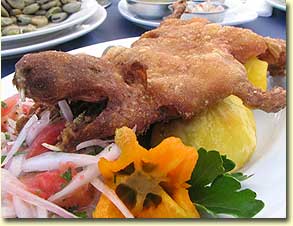
 The majority of Peruvians either reside high up in the Andes Mountains,
along the Pacific coastline or in small communities in the mighty Amazon
Jungle. Arequipa will take your breath away. Not because it is nestled
some two and a half thousand metres up in the Inca mountains, its sheer
magnificence and beauty is awesome.
The majority of Peruvians either reside high up in the Andes Mountains,
along the Pacific coastline or in small communities in the mighty Amazon
Jungle. Arequipa will take your breath away. Not because it is nestled
some two and a half thousand metres up in the Inca mountains, its sheer
magnificence and beauty is awesome.  really is. A quick glance towards the snow capped peaks of
El Misti, Chachani and
Pichu Pichu, three mountains that surround the
northern section of the city, does have a cooling affect. El Misti in particular is so extraordinary; it protrudes from the
barren
floor of the plateau on the north east side of the city to reach a
height just shy of six thousand metres. The fast paced icy waters that
run down the Chili River Valley from the mountains provide irrigation
for the farmland and allotments in one of the driest areas in the world.
really is. A quick glance towards the snow capped peaks of
El Misti, Chachani and
Pichu Pichu, three mountains that surround the
northern section of the city, does have a cooling affect. El Misti in particular is so extraordinary; it protrudes from the
barren
floor of the plateau on the north east side of the city to reach a
height just shy of six thousand metres. The fast paced icy waters that
run down the Chili River Valley from the mountains provide irrigation
for the farmland and allotments in one of the driest areas in the world. After
many hours of somewhat boring and wearisome travel, my flight was about
to touch down in the heart of the Andes. I was to see first hand what
life in this beckoning part of the world is all about.
My mission was to work with staff and students of the “Instituto de
Sur”, a hospitality College in the downtown core of the city. ISUR, was to be one of many industry participants in the debut of a
festival promoting the foods and beverages of the area. The event was
called “
After
many hours of somewhat boring and wearisome travel, my flight was about
to touch down in the heart of the Andes. I was to see first hand what
life in this beckoning part of the world is all about.
My mission was to work with staff and students of the “Instituto de
Sur”, a hospitality College in the downtown core of the city. ISUR, was to be one of many industry participants in the debut of a
festival promoting the foods and beverages of the area. The event was
called “ The drive from the airport to downtown was, well let’s say a reality
check.
Peru is a poverty stricken country of some twenty seven million people,
fifty four percent of which live in dire conditions. Neighborhoods on
the outer perimeter of the city house people in homes constructed of
corrugated iron and cardboard without running water or hydro.
The drive from the airport to downtown was, well let’s say a reality
check.
Peru is a poverty stricken country of some twenty seven million people,
fifty four percent of which live in dire conditions. Neighborhoods on
the outer perimeter of the city house people in homes constructed of
corrugated iron and cardboard without running water or hydro.  eventually sputtering to a complete stop. My driver, with a sheepish
grin, jumped out and grabbed an “
eventually sputtering to a complete stop. My driver, with a sheepish
grin, jumped out and grabbed an “ My purpose at the festival was to perform three demonstrations on fusion
food using Arequipan recipes as the foundation. I must confess to being
a little anxious, but after meeting the staff and student volunteers at
the college, the warm and genuine welcome I received calmed my nerves
completely.
My purpose at the festival was to perform three demonstrations on fusion
food using Arequipan recipes as the foundation. I must confess to being
a little anxious, but after meeting the staff and student volunteers at
the college, the warm and genuine welcome I received calmed my nerves
completely.  My main course was authentic, I chose to tackle a whole deep fried
Guinea pig complete with liver, kidneys and other such dangly bits.
It tasted similar to pork, only richer and more complex. I really
enjoyed it.
My main course was authentic, I chose to tackle a whole deep fried
Guinea pig complete with liver, kidneys and other such dangly bits.
It tasted similar to pork, only richer and more complex. I really
enjoyed it.

 burners
and the intense brightness of the sun made video reproduction difficult.
All in all it went really well, people were appreciative and the
bottle of icy chilled Arequipina beer slurped down immediately after was
most welcome.
burners
and the intense brightness of the sun made video reproduction difficult.
All in all it went really well, people were appreciative and the
bottle of icy chilled Arequipina beer slurped down immediately after was
most welcome. 
 Juan Carlos, who works at the ISUR mentioned to me that as a chef, I
might enjoy San Camilo, the daily
downtown market. I was there as soon as its doors opened at 5 AM. This place is not for the faint of heart. It is full of vendors
selling anything from animals still warm and bleeding, to vegetables,
fruits and breads. One can find merchants selling dried creatures of all
sorts destined to be part of medicinal potions.
Juan Carlos, who works at the ISUR mentioned to me that as a chef, I
might enjoy San Camilo, the daily
downtown market. I was there as soon as its doors opened at 5 AM. This place is not for the faint of heart. It is full of vendors
selling anything from animals still warm and bleeding, to vegetables,
fruits and breads. One can find merchants selling dried creatures of all
sorts destined to be part of medicinal potions.  carrying a pig hustling through
crowds passing tables strewn with poultry, mountains of fish and sides
of aging lamb and alpaca. A leather skinned sun drenched man dressed in
jeans and a blood soaked t-shirt butchers beef with professional ease as
the potato vendor at another booth flaunts his wares with pride.
carrying a pig hustling through
crowds passing tables strewn with poultry, mountains of fish and sides
of aging lamb and alpaca. A leather skinned sun drenched man dressed in
jeans and a blood soaked t-shirt butchers beef with professional ease as
the potato vendor at another booth flaunts his wares with pride.  At one lunch I fought my way through a triple pork platter composed of a
Ricoto Relleno,
Chicharron, marinated
Head Cheese and Pig’s Trotters.
The quintessential Peruvian pepper, the Ricoto, is the perfect size to
stuff and offers the diner a layer of heat that is just perfect, spicy,
but full of flavour. The top is removed and the capsule is stuffed with
a mixture I would compare to a Bolognaise sauce only made with pork and
the meat was diced not ground.
Before baking it is topped with Queso Blanco cheese.
At one lunch I fought my way through a triple pork platter composed of a
Ricoto Relleno,
Chicharron, marinated
Head Cheese and Pig’s Trotters.
The quintessential Peruvian pepper, the Ricoto, is the perfect size to
stuff and offers the diner a layer of heat that is just perfect, spicy,
but full of flavour. The top is removed and the capsule is stuffed with
a mixture I would compare to a Bolognaise sauce only made with pork and
the meat was diced not ground.
Before baking it is topped with Queso Blanco cheese.  The ingestion of all that pork fat is probably not the best thing in
what we consider to be part of a healthy well balanced diet, but I know
when the inevitable onslaught of winter arrives, I will be wishing I was
on a sun drench patio in Arequipa eating Chicharron and sipping Pisco
Sours.
The ingestion of all that pork fat is probably not the best thing in
what we consider to be part of a healthy well balanced diet, but I know
when the inevitable onslaught of winter arrives, I will be wishing I was
on a sun drench patio in Arequipa eating Chicharron and sipping Pisco
Sours.  The
The 